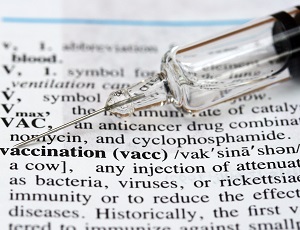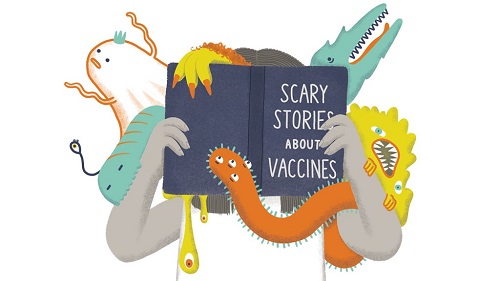
The last few years marked a dramatic rise in distrust towards vaccination. A somewhat substantial portion of the general population became suspicious of the procedure, as it’s one of the very few performed on healthy people, particularly children. Additionally, vaccination is quite often administered involuntarily. These misgivings are further deepened by various anti-vax movements which seek to downplay the benefits of vaccination and change the policies that regulate it.
Although vaccination is widely recognised by experts as highly effective means of fighting diseases,1 the public debate on its safety – often full of sophistry, manipulated statistics, and anecdotal evidence – is rife with myths and false claims. With the help of Dr Magdalena Kozela and Dr Michał Zabdyr-Jamróz from the JU Faculty of Health Sciences, we debunk the most common misconceptions in the article below, citing the latest medical research.
Myth #1: Excessive vaccination causes diseases of affluence
A significant increase in sanitation, access to running water, refrigerators, preventive vaccines, and antibiotics have dramatically diminished the overall incidence and mortality rate of numerous diseases. Simultaneously, more and more people have started suffering from other types of non-infectious illnesses: diabetes, obesity, allergies, cancer, autism, and mental disorders. All of those ailments can have multiple causes, many of which are not yet fully understood. Collectively, they’re known as diseases of affluence, since they’re commonly thought to be the result of increasing wealth in society. Many of them are rather obviously related to the fact that we live longer and aren’t as susceptible to diseases that caused much harm to our ancestors. Ironically, we’re now able to experience age-related health problems that were previously undiscovered due to people's shorter lifespan.
 Recognising a particular factor (in this case: vaccines) as a cause of any disease is a long and demanding process. In epidemiology, there are several rules which govern it:
Recognising a particular factor (in this case: vaccines) as a cause of any disease is a long and demanding process. In epidemiology, there are several rules which govern it:
- a factor has to always coincide with the illness – it’s not enough to determine that the two sometimes appear together (for instance, autism is often diagnosed around the same age that vaccines are administered);
- a factor has to be observed in large and diverse groups of patients (i.e. of various nationalities or ages) so that trend analysis does not lead to false conclusions (post hoc fallacy, see above);
- a factor has to have etiopathogenetic relationship with the disease – there has to be a direct connection between the two (e.g. a mechanism leading to diabetes, cancer etc.), mere statistics are not enough;
- removing the factor should decrease the risk of the disease occurring.
The vast majority of arguments regarding the alleged connection between vaccines and diseases of affluence fail to meet these requirements. Furthermore, there are many examples of research studies which clearly demonstrate the lack of such connection.2–4
Myth #2: Vaccines cause autism
It’s very important to understand that a single research study might be misleading or simply false due to incorrect methodology – or even fraud. In order to be considered reliable, the results of any given research project must be reproducible. Until the conclusions of a study are confirmed by other scientists, they should be approached with scepticism and caution, particularly if said conclusions are shocking, sensational, and contradictory to universally established scientific knowledge. To ensure the maximum trustworthiness of research, all papers published in scientific journals undergo the process of peer review. This is done in absolute anonymity. The reviewers accept or reject a paper based solely on its scientific merits, often indicating the necessity to elaborate on or clarify certain issues. However, this process is not perfect: it’s vulnerable to cheating attempts, as reviewers often assume authors’ good intentions and try to help them improve their writing proficiency and argumentation.
A perfect – and unfortunately, highly influential – example of this is Andrew Wakefield’s 1998 article published in The Lancet.5 It described an alleged relationship between autism in children and the MMR vaccine (a vaccine against measles, mumps and rubella). Six years later, Brian Deer from The Sunday Times6 proved such a relationship does not exist. Further inquiry into the subject resulted in The Lancet removing Wakefield’s article in 2010,7 and the scientist was barred from practicing medicine in the UK, having been found guilty of many unethical practices, ranging from conflict of interest to abuse of developmentally delayed children. In spite of this scandalous affair, Wakefield’s article is still disseminated by anti-vaccine activists as ‘proof’ of their harmfulness.
Myth #3: Vaccination should be voluntary – there will be no ill effects
 The regulations concerning vaccination vary greatly between countries around the world. For instance, the Scandinavian countries boast 95–99% vaccination coverage levels, even though the procedure is completely voluntary. Conversely, some countries where vaccination is mandatory, such as France, struggle to reach that level and achieve herd immunity (a situation in which a disease has a difficult time spreading within a population due to the sheer number of immunised people).
The regulations concerning vaccination vary greatly between countries around the world. For instance, the Scandinavian countries boast 95–99% vaccination coverage levels, even though the procedure is completely voluntary. Conversely, some countries where vaccination is mandatory, such as France, struggle to reach that level and achieve herd immunity (a situation in which a disease has a difficult time spreading within a population due to the sheer number of immunised people).
When determining health care policies, governments often aim to achieve herd immunity, frequently through mandatory vaccination. Although it’s neither perfect nor applicable in every case, it’s still very much one of the most effective tools of combating diseases and protecting the most vulnerable members of society (herd immunity protects people that cannot be vaccinated). According to most estimates, abandoning mandatory vaccination would only make things worse.
Myth #4: Vaccination is harmful to prematurely born children
The current Polish vaccination programme states that prematurely born children should be inoculated with respect to their chronological age, i.e. starting with the day of their birth. The reasoning behind this is that preemies are particularly susceptible to diseases, since their immune system is not yet fully developed. They have received fewer antibodies from their mothers, and are less immune to bacteria and viruses on the cellular level, meaning they are more prone to becoming infected than other children.
Many studies show that prematurely born infants have a higher chance of being taken with illnesses such as with invasive pneumococcal disease and whooping cough, which pose an extreme threat to their health. It’s been confirmed that vaccinating against these diseases lowers the risk of infection in all infants, including preemies.8–10 Furthermore, it’s been established that premature birth increases the probability of flu complications, and vaccination helps to avoid them.10
Myth #5: Children are over-vaccinated
 On the first day after birth, a baby’s pulmonary and digestive system, along with its skin, are colonised by an immense number of microorganisms. In that moment, the child’s immune system begins learning how to fight infection. It’s estimated that every square centimetre of healthy skin is home to around one thousand bacteria, and one gram of saliva contains about a hundred million of them. When we take into account the natural behaviour of small children when they’re playing with their friends in nursery schools or playgrounds, it becomes apparent that it’s normal for them to be exposed to vast amounts of antigens. Meanwhile, the average vaccine intended for children contains only several of them.
On the first day after birth, a baby’s pulmonary and digestive system, along with its skin, are colonised by an immense number of microorganisms. In that moment, the child’s immune system begins learning how to fight infection. It’s estimated that every square centimetre of healthy skin is home to around one thousand bacteria, and one gram of saliva contains about a hundred million of them. When we take into account the natural behaviour of small children when they’re playing with their friends in nursery schools or playgrounds, it becomes apparent that it’s normal for them to be exposed to vast amounts of antigens. Meanwhile, the average vaccine intended for children contains only several of them.
The results published in the Journal of American Medical Association in 2018 show that administering multiple vaccines during the first two years of a baby’s life has no negative impact on its immune system. The authors counted the total number of antigens in vaccines administered to children in the first 23 months of their lives. Then, they compared the number of administered antigens between children aged 2–4 who have fallen for illnesses not targeted by vaccines and randomly chosen children who were never sick. The accumulated number of antigens did not differ significantly between the two, proving there is no meaningful connection between vaccination and later development of infections.11
Myth #6: Vaccine deniers base their claims on hard evidence
Information disseminated by anti-vaccine organisations is quite straightforward. They attention of the general public by citing individual examples of negative phenomena (anecdotal evidence) in order to evoke strong emotions. Such accounts are almost never backed up by medical professionals, but rather self-proclaimed ‘experts’ armed with arguments carefully selected to match their biases. The simplicity and unambiguity of their claims is rooted directly in their incomplete understanding of the subject matter of outright manipulation.
Reliable scientific knowledge stemming from trustworthy sources is very rarely so simple and unambiguous, much less shocking or sensational. It’s the result of a plethora research studies painstakingly conducted by a number scholars over the period of many years. The scientific method is designed to root out any prejudice and partiality, removing any emotional or financial motivations from the equation. Explaining convoluted scientific concepts to lay people is often a tremendous effort, akin to translating ideas from one language to another. It requires in-depth knowledge about specialist terms used in science and the ability to adequately render them in everyday language. Because of that, research result are often misinterpreted by those lacking the proper training.
A recent study examined the relationship between the level of knowledge about autism spectrum disorders and the opinion of vaccination policy. It turned out that people who believed themselves to be more knowledgeable about autism than medical professionals were less likely to condone pro-vaccination policy and more likely to support activists without formal medical education.12 This psychological phenomenon, known as the Dunning-Kruger effect, is common in all branches of knowledge. It’s a cognitive bias in which people with low ability mistakenly assess their expertise as greater than it actually is (in other words: the more knowledge someone has, the more cautious they are when passing judgement).
Don’t be fooled
In Poland, there is a recurring discussion on the justification of vaccination safety. Lately, more and more people choose to shirk from the responsibility of vaccinating their children. However, according to a poll from August 2017, the vast majority (80%) of Poles acknowledge the positive effects of vaccination and supports the mandatory requirement. Only 12% of Poles believe that vaccination should be voluntary, with the final decision falling to parents, though the poll also showed that parents' understanding of the subject is somewhat limited. What’s interesting, people in Poland, particularly those who have children, would prefer limiting the interaction between vaccinated and unvaccinated children rather than imposing financial penalties on the parents of unvaccinated children.13
Vaccination is widely recognised as the most effective method of protection against infectious diseases. There are no credible research studies which prove there is a connection between inoculation and non-infectious diseases. It’s a procedure which benefits not only an individual, but also society at large. It’s one of the reasons why vaccination policies should only be decided by those possessing proper medical training.
Anti-vaxxers make up a fraction of the population and seldom are medical professionals. Their claims are not supported by scientific studies. Fortunately, most people understand and appreciate the positive role vaccination plays in our lives.
Sources:
- Matkowska-Kocjan A., Szenborn L. 2010. Bezpieczeństwo szczepień w świetle najnowszej wiedzy medycznej. Przewodnik Lekarza, 13(5).
- Morgan E., Halliday S.R., Campbell G.R., Cardwell C.R., Patterson C.C. 2016. Vaccinations and childhood type 1 diabetes mellitus: a meta-analysis of observational studies. Diabetologia, 59(2): 237-43.
- Madsen K.M., Hviid A., Vestergaard M., Schendel D., Wohlfahrt J., Thorsen P., Olsen J., Melbye M. 2002. A population-based study of measles, mumps, and rubella vaccination and autism. N Engl J Med., 347(19): 1477-82.
- El-Zein M., Conus F., Benedetti A., Menzies D., Parent M.E., Rousseau M.C. 2017. Association Between Bacillus Calmette-Guérin Vaccination and Childhood Asthma in the Quebec Birth Cohort on Immunity and Health. Am J Epidemiol., 1; 186(3): 344-355.
- Wakefield A. J. et al. 1998. Ileal-lymphoid-nodular hyperplasia, non-specific colitis, and pervasive developmental disorder in children, The Lancet, 351(9103): 637-641.
- Deer B. 2011. How the case against the MMR vaccine was fixed, British Medical Journal, 342, art. nr c5347.
- The Lancet 2010. Retraction: Ileal-lymphoid-nodular hyperplasia, non-specific colitis, and pervasive developmental disorder in children, The Lancet, 375(9713): 445.
- Riise Ø.R., Laake I., Vestrheim D., Winje B.A., Moster D., Storsæter J. 2018. Preterm Children Have Higher Risk Than Full-term Children of Invasive Pneumococcal Disease During the First 2 Years of Life. Pediatr Infect Dis J., 37(7): e195-e200.
- Riise Ø.R., Laake I., Vestrheim D., Flem E., Moster D., Riise Bergsaker M.A., Storsæter 2017. Risk of Pertussis in Relation to Degree of Prematurity in Children Less Than 2 Years of Age. J.Pediatr Infect Dis J., 36(5): e151-e156.
- Gill P.J., Ashdown H.F., Wang K., Heneghan C., Roberts N.W., Harnden A., Mallett S. 2015. Identification of children at risk of influenza-related complications in primary and ambulatory care: a systematic review and meta-analysis. Lancet Respir Med. Feb; 3(2): 139-149.
- Glanz J.M., Newcomer S.R., Daley M.F., et al. 2018. Association Between Estimated Cumulative Vaccine Antigen Exposure Through the First 23 Months of Life and Non–Vaccine-Targeted Infections From 24 Through 47 Months of Age. JAMA. 319(9): 906–913.
- Motta M., Callaghan T., Sylvester S. 2018. Knowing less but presuming more: Dunning-Kruger effects and the endorsement of anti-vaccine policy attitudes. Soc Sci Med. Aug 211: 274-281.
- CBOS 2017. Komunikat z badań, nr 100/2017, Warszawa





